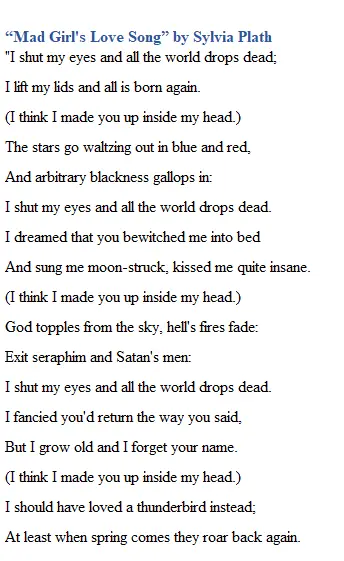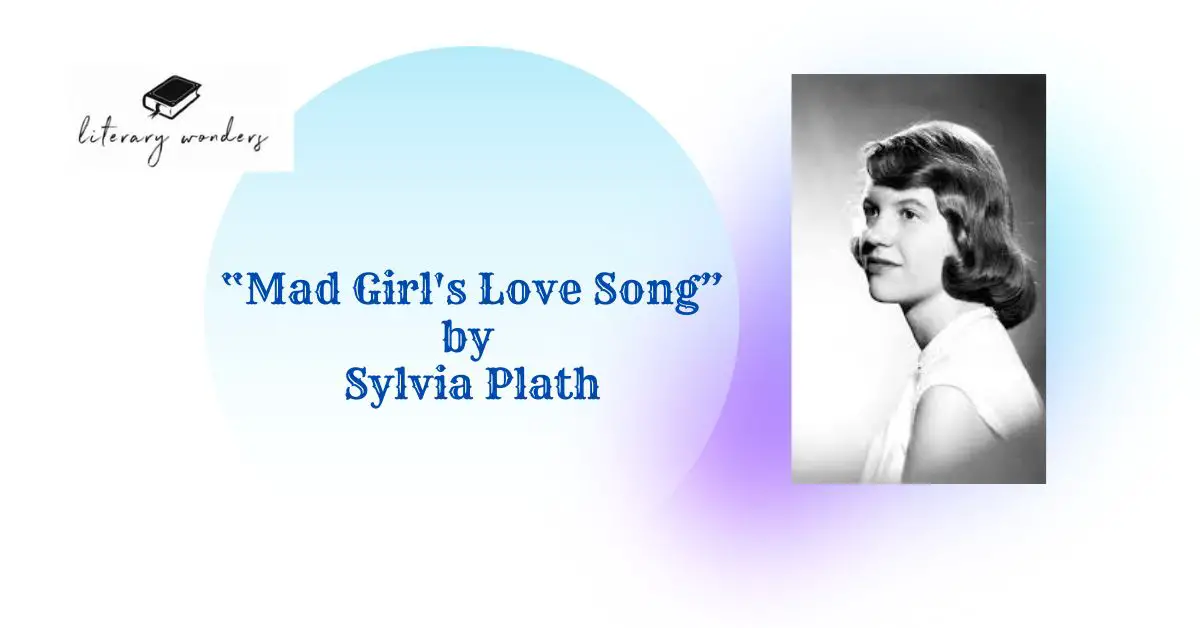Analysis of the Poem “Mad Girl’s Love Song”

- Introduction to “Mad Girl’s Love Song”: “Mad Girl’s Love Song” is a melancholy lyrical work that was first published in Mademoiselle in 1953. In this poem, the outstanding American poet and author Sylvia Plath captures the agony that follows a significant loss. She also touches on several factors that can lead a healthy individual to develop mental illness. The poem, however, rose to fame because it depicts love as an invention of the mind.
- Representation of Pain in “Mad Girl’s Love Song”: The speaker’s sad period of life is depicted in this poem. She starts it off by hanging between imagination and reality. Ironically, she claims that the world dies when she closes her eyes and finally comes to life when she opens them again. The speaker is being pushed toward darkness as she perceives feelings of gladness progressively fading. In the third stanza, she connects her suffering to love while demonstrating how to spell “bounded by love.” The lover of the speaker is not present anymore. She, therefore, tries to express her anguish to her beloved. She expected her beloved to return, but it never did. The speaker must endure the suffering of separation. She concludes this sad, poetic piece by stating that she ought to have loved a thunderbird that makes a comeback after winter is ended. But her beloved is gone, and he doesn’t seem to be coming back.
- Themes in “Mad Girl’s Love Song”: Some of the major themes include lost love, agony, sorrow, and depression. This poem deftly depicts the suffering of a woman who experienced tragedy in love. She appears to have been unprepared for this unfortunate turn of events, and the shock has made her world seem hopeless. She has lost her joy, and the world has also lost its allure. She struggles to deal with her problems, vacillating between melancholy and denial. She shuts her eyes and denies the existence of her lost love throughout the poem, disengaging herself from reality. Despite her repeated attempts to flee the misery in her life, she only encountered isolation and darkness. She makes little progress in returning to the land of light. She criticizes herself for following her heart in a fruitless direction.
Poetic Elements Used in “Mad Girl’s Love Song”
In order to convey the suffering and trauma people experience after losing their love, Sylvia Plath uses a number of literary techniques in her poem. The following is an analysis of the literary devices used in this poem.
- Assonance: The recurrence of vowel sounds inside a single line is known as assonance. Examples include the sound of /e/ in “The stars go waltzing out in blue and red” and the sound of /o/ in “God topples from the sky, hell’s fires fade:”
- Anaphora: The recurrence of a word or phrase in the opening of several verses is known as anaphora. To stress a point, Plath uses the word “I” multiple times in the poem’s first stanza.
“I shut my eyes and all the world drops dead;
I lift my lids and all is born again.”
- Allusion: A person, place, thing, or idea with historical, cultural, political, or literary significance may be allusively referred to in writing. The speaker’s anxiousness and depression are alluded to in the following sentences.
“I shut my eyes and all the world drops dead;
I lift my lids and all is born again.”
- Consonance: The repeating of consonant sounds inside a single line is referred to as consonance. Examples include the sound of /t/ in “I dreamed that you bewitched me into bed” and the sound of /n/ in “Exit seraphim and Satan’s men.”
- Diction: The poem uses a descriptive diction with rhetorical tactics, symbolism, and powerful pictures.
- Enjambment: Enjambment is described as a poem form in which a concept continues onto the next line rather than ending at the line break. For instance;
“I dreamed that you bewitched me into bed
And sung me moon-struck, kissed me quite insane.”
- Imagery: Using imagery, authors can influence how readers experience things using all five senses. In this poem, Sylvia Plath uses imagery like “God topples from the sky, hell’s fires fade,” and “I fancied you’d return the way you said,” among other lines.
- Metaphor: This figure of speech implies a comparison between two fundamentally unrelated things. The poet illustrates the suffering one has after being betrayed in the name of love by using the expanded metaphor of love.
- Repetition: The poem has a melodic effect thanks to the repeated line “I shut my eyes and all the world drops dead.”
- Refrain: The refrain in a poem refers to a line that appears more than once at a distance. The poem’s opening line, “I shut my eyes and all the world drops dead,” is repeated throughout all of the stanzas and has taken on the form of a refrain.
- Stanza: A stanza is a grouping of lines into a poem. This poem has six stanzas, each of which has three lines.
- Symbolism: Symbolism is the use of symbols to represent concepts and traits by giving them deeper, more symbolic meanings than their literal interpretations. Symbols like love, grief, suffering, despair, and tension are depicted in the poem.
The study demonstrates that this poetry is complex and easy to understand because of the use of these strategies.
FAQS about “Mad Girl’s Love Song”
1. Why “Mad Girl’s Love Song” by Sylvia Plath is famous?
“Mad Girl’s Love Song” by American poet Sylvia Plath was first published in 1953 and is known for its exploration of universal thematic strand of lost love, madness, and the complexities of romantic relationships.
2. What does the title “Mad Girl’s Love Song” signify?
The title signifies that the poem is written from the perspective of a woman who is struggling with her emotions and sanity. Also, it sets the tone for the poem’s exploration of the speaker’s inner turmoil.
3. Who is the speaker in “Mad Girl’s Love Song”?
The speaker in the poem is interpreted as the writer herself or a persona closely associated with her. It reflects the inner thoughts and emotions of a woman who is fighting with the complexities of love.
4. What is the major theme of the poem?
The central theme of the poem is the agony and confusion that can accompany love. It explores the speaker’s conflicting emotions, and her struggle to make sense of her feelings for someone.
5. What is the significance of the phrase “I shut my eyes and all the world drops dead” in the poem?
The above-stated line suggests the intensity of the speaker’s emotions. When she closes her eyes, her entire world seems to collapse or lose its meaning. It highlights the idea that love can be all-consuming and overwhelming.
6. How does the pom explore the theme of mental health?
The poem provides insights into the speaker’s mental state, which is characterized by moments of instability and turmoil. It raises questions about the connection between love, sanity, and madness.
7. What is the lasting impact of “Mad Girl’s Love Song” in the world of poetry?
“Mad Girl’s Love Song” is considered one of Sylvia Plath’s significant works and continues to be studied and admired for its exploration of complex emotions and its contribution to the genre of confessional poetry. It remains relevant in discussions about love, mental health, and creativity in literature.
Suggested Readings

